Leading and Motivating People - CBE6184: Report Analysis
VerifiedAdded on 2023/01/18
|20
|4952
|61
Report
AI Summary
This report examines the realities of leading, managing, and changing businesses, with a focus on neuro-leadership. It provides a detailed analysis of brain leadership, change management, and the BAL Model, which encompasses creative thinking, emotions, brain automation, and relations. The report explores how understanding the human brain is key to effective leadership and change management. It also includes a case study of Procter & Gamble's change management initiatives. The analysis emphasizes that successful change management requires a considerate approach that reduces anxiety and stress among employees. The report concludes with recommendations for leaders and human resource professionals to implement effective change strategies within organizations.

Running head: LEADING AND MANAGING PEOPLE
Leading and Motivating People
4/9/2019
Leading and Motivating People
4/9/2019
Paraphrase This Document
Need a fresh take? Get an instant paraphrase of this document with our AI Paraphraser
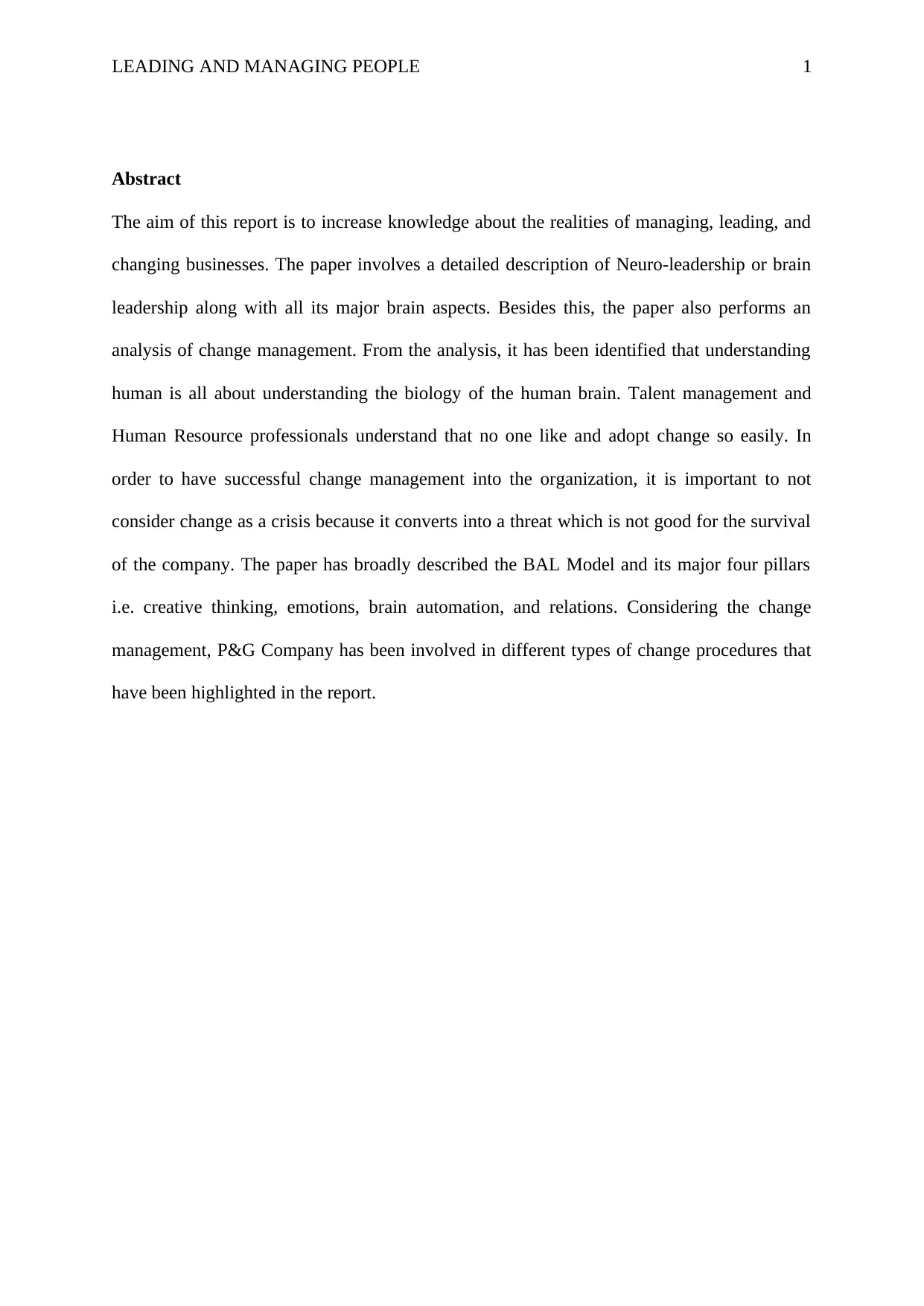
LEADING AND MANAGING PEOPLE 1
Abstract
The aim of this report is to increase knowledge about the realities of managing, leading, and
changing businesses. The paper involves a detailed description of Neuro-leadership or brain
leadership along with all its major brain aspects. Besides this, the paper also performs an
analysis of change management. From the analysis, it has been identified that understanding
human is all about understanding the biology of the human brain. Talent management and
Human Resource professionals understand that no one like and adopt change so easily. In
order to have successful change management into the organization, it is important to not
consider change as a crisis because it converts into a threat which is not good for the survival
of the company. The paper has broadly described the BAL Model and its major four pillars
i.e. creative thinking, emotions, brain automation, and relations. Considering the change
management, P&G Company has been involved in different types of change procedures that
have been highlighted in the report.
Abstract
The aim of this report is to increase knowledge about the realities of managing, leading, and
changing businesses. The paper involves a detailed description of Neuro-leadership or brain
leadership along with all its major brain aspects. Besides this, the paper also performs an
analysis of change management. From the analysis, it has been identified that understanding
human is all about understanding the biology of the human brain. Talent management and
Human Resource professionals understand that no one like and adopt change so easily. In
order to have successful change management into the organization, it is important to not
consider change as a crisis because it converts into a threat which is not good for the survival
of the company. The paper has broadly described the BAL Model and its major four pillars
i.e. creative thinking, emotions, brain automation, and relations. Considering the change
management, P&G Company has been involved in different types of change procedures that
have been highlighted in the report.
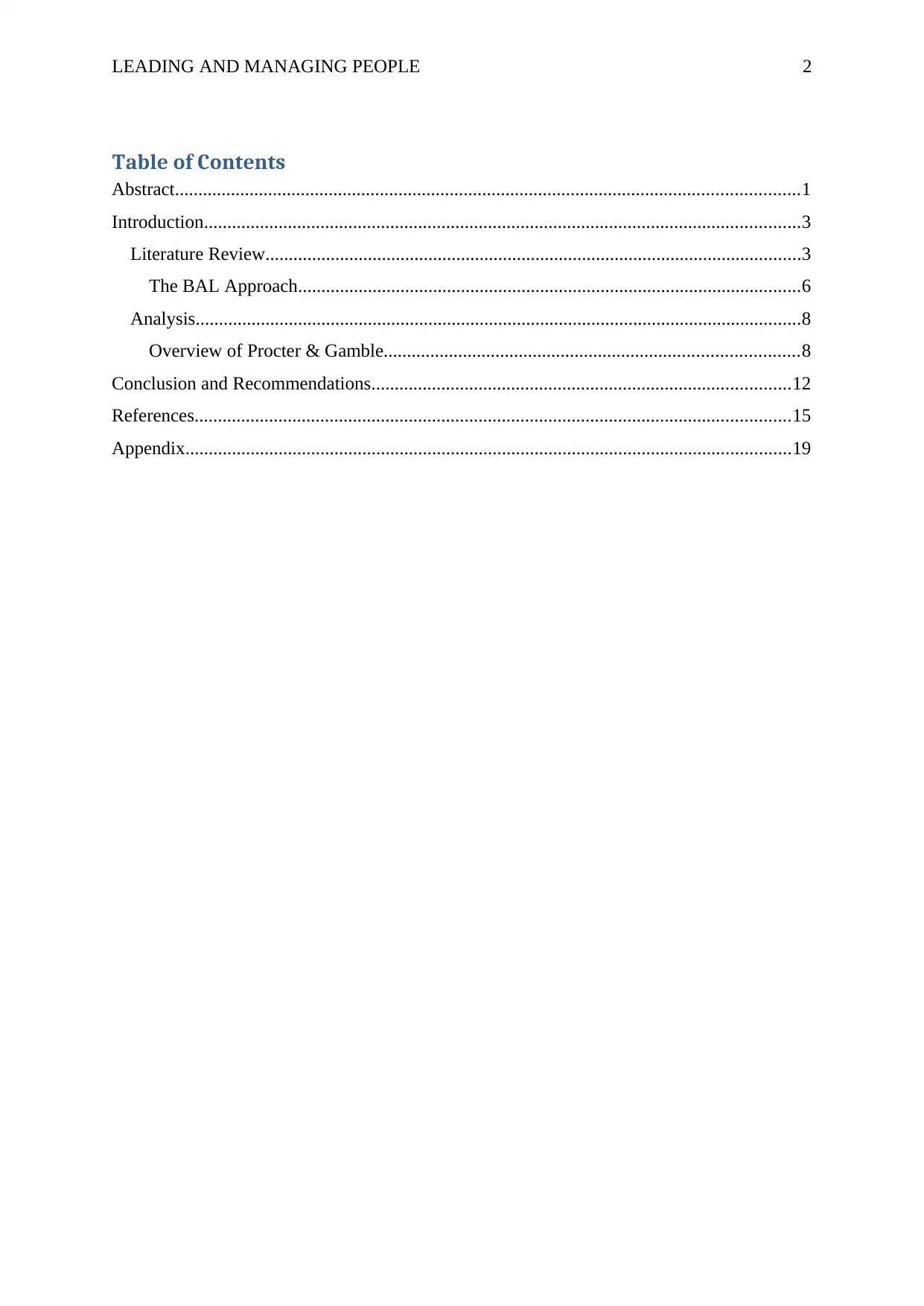
LEADING AND MANAGING PEOPLE 2
Table of Contents
Abstract......................................................................................................................................1
Introduction................................................................................................................................3
Literature Review...................................................................................................................3
The BAL Approach............................................................................................................6
Analysis..................................................................................................................................8
Overview of Procter & Gamble.........................................................................................8
Conclusion and Recommendations..........................................................................................12
References................................................................................................................................15
Appendix..................................................................................................................................19
Table of Contents
Abstract......................................................................................................................................1
Introduction................................................................................................................................3
Literature Review...................................................................................................................3
The BAL Approach............................................................................................................6
Analysis..................................................................................................................................8
Overview of Procter & Gamble.........................................................................................8
Conclusion and Recommendations..........................................................................................12
References................................................................................................................................15
Appendix..................................................................................................................................19
⊘ This is a preview!⊘
Do you want full access?
Subscribe today to unlock all pages.

Trusted by 1+ million students worldwide
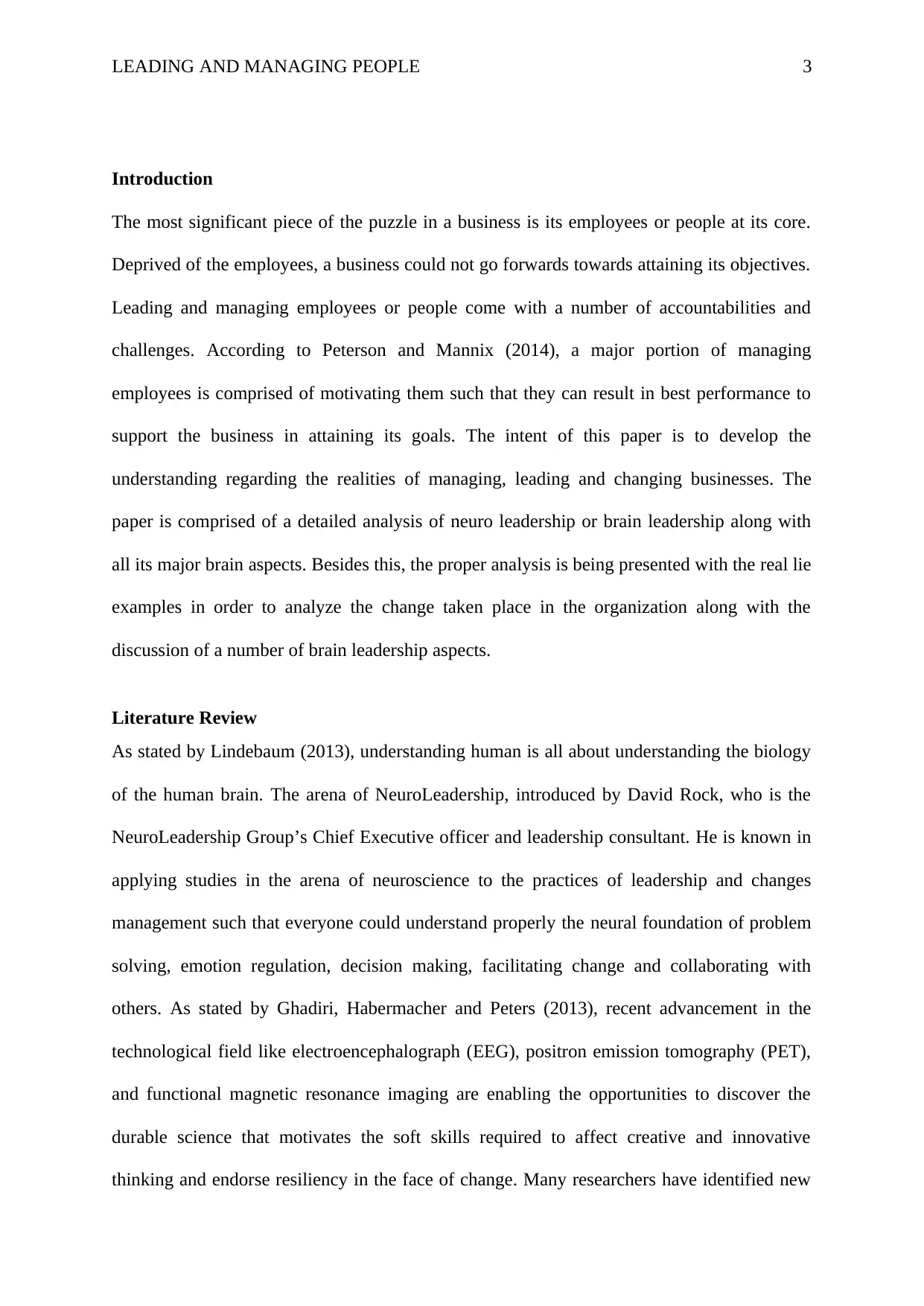
LEADING AND MANAGING PEOPLE 3
Introduction
The most significant piece of the puzzle in a business is its employees or people at its core.
Deprived of the employees, a business could not go forwards towards attaining its objectives.
Leading and managing employees or people come with a number of accountabilities and
challenges. According to Peterson and Mannix (2014), a major portion of managing
employees is comprised of motivating them such that they can result in best performance to
support the business in attaining its goals. The intent of this paper is to develop the
understanding regarding the realities of managing, leading and changing businesses. The
paper is comprised of a detailed analysis of neuro leadership or brain leadership along with
all its major brain aspects. Besides this, the proper analysis is being presented with the real lie
examples in order to analyze the change taken place in the organization along with the
discussion of a number of brain leadership aspects.
Literature Review
As stated by Lindebaum (2013), understanding human is all about understanding the biology
of the human brain. The arena of NeuroLeadership, introduced by David Rock, who is the
NeuroLeadership Group’s Chief Executive officer and leadership consultant. He is known in
applying studies in the arena of neuroscience to the practices of leadership and changes
management such that everyone could understand properly the neural foundation of problem
solving, emotion regulation, decision making, facilitating change and collaborating with
others. As stated by Ghadiri, Habermacher and Peters (2013), recent advancement in the
technological field like electroencephalograph (EEG), positron emission tomography (PET),
and functional magnetic resonance imaging are enabling the opportunities to discover the
durable science that motivates the soft skills required to affect creative and innovative
thinking and endorse resiliency in the face of change. Many researchers have identified new
Introduction
The most significant piece of the puzzle in a business is its employees or people at its core.
Deprived of the employees, a business could not go forwards towards attaining its objectives.
Leading and managing employees or people come with a number of accountabilities and
challenges. According to Peterson and Mannix (2014), a major portion of managing
employees is comprised of motivating them such that they can result in best performance to
support the business in attaining its goals. The intent of this paper is to develop the
understanding regarding the realities of managing, leading and changing businesses. The
paper is comprised of a detailed analysis of neuro leadership or brain leadership along with
all its major brain aspects. Besides this, the proper analysis is being presented with the real lie
examples in order to analyze the change taken place in the organization along with the
discussion of a number of brain leadership aspects.
Literature Review
As stated by Lindebaum (2013), understanding human is all about understanding the biology
of the human brain. The arena of NeuroLeadership, introduced by David Rock, who is the
NeuroLeadership Group’s Chief Executive officer and leadership consultant. He is known in
applying studies in the arena of neuroscience to the practices of leadership and changes
management such that everyone could understand properly the neural foundation of problem
solving, emotion regulation, decision making, facilitating change and collaborating with
others. As stated by Ghadiri, Habermacher and Peters (2013), recent advancement in the
technological field like electroencephalograph (EEG), positron emission tomography (PET),
and functional magnetic resonance imaging are enabling the opportunities to discover the
durable science that motivates the soft skills required to affect creative and innovative
thinking and endorse resiliency in the face of change. Many researchers have identified new
Paraphrase This Document
Need a fresh take? Get an instant paraphrase of this document with our AI Paraphraser
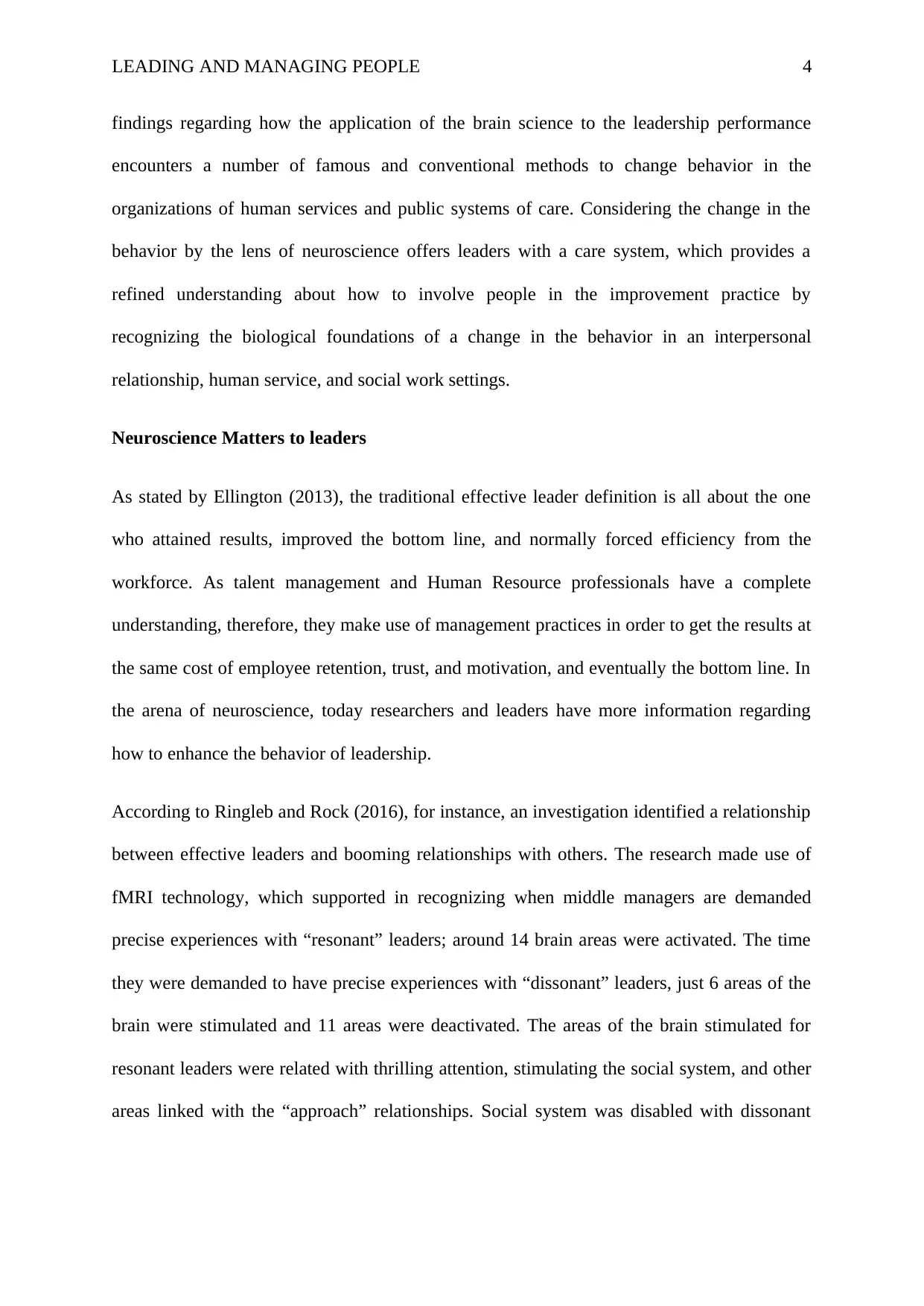
LEADING AND MANAGING PEOPLE 4
findings regarding how the application of the brain science to the leadership performance
encounters a number of famous and conventional methods to change behavior in the
organizations of human services and public systems of care. Considering the change in the
behavior by the lens of neuroscience offers leaders with a care system, which provides a
refined understanding about how to involve people in the improvement practice by
recognizing the biological foundations of a change in the behavior in an interpersonal
relationship, human service, and social work settings.
Neuroscience Matters to leaders
As stated by Ellington (2013), the traditional effective leader definition is all about the one
who attained results, improved the bottom line, and normally forced efficiency from the
workforce. As talent management and Human Resource professionals have a complete
understanding, therefore, they make use of management practices in order to get the results at
the same cost of employee retention, trust, and motivation, and eventually the bottom line. In
the arena of neuroscience, today researchers and leaders have more information regarding
how to enhance the behavior of leadership.
According to Ringleb and Rock (2016), for instance, an investigation identified a relationship
between effective leaders and booming relationships with others. The research made use of
fMRI technology, which supported in recognizing when middle managers are demanded
precise experiences with “resonant” leaders; around 14 brain areas were activated. The time
they were demanded to have precise experiences with “dissonant” leaders, just 6 areas of the
brain were stimulated and 11 areas were deactivated. The areas of the brain stimulated for
resonant leaders were related with thrilling attention, stimulating the social system, and other
areas linked with the “approach” relationships. Social system was disabled with dissonant
findings regarding how the application of the brain science to the leadership performance
encounters a number of famous and conventional methods to change behavior in the
organizations of human services and public systems of care. Considering the change in the
behavior by the lens of neuroscience offers leaders with a care system, which provides a
refined understanding about how to involve people in the improvement practice by
recognizing the biological foundations of a change in the behavior in an interpersonal
relationship, human service, and social work settings.
Neuroscience Matters to leaders
As stated by Ellington (2013), the traditional effective leader definition is all about the one
who attained results, improved the bottom line, and normally forced efficiency from the
workforce. As talent management and Human Resource professionals have a complete
understanding, therefore, they make use of management practices in order to get the results at
the same cost of employee retention, trust, and motivation, and eventually the bottom line. In
the arena of neuroscience, today researchers and leaders have more information regarding
how to enhance the behavior of leadership.
According to Ringleb and Rock (2016), for instance, an investigation identified a relationship
between effective leaders and booming relationships with others. The research made use of
fMRI technology, which supported in recognizing when middle managers are demanded
precise experiences with “resonant” leaders; around 14 brain areas were activated. The time
they were demanded to have precise experiences with “dissonant” leaders, just 6 areas of the
brain were stimulated and 11 areas were deactivated. The areas of the brain stimulated for
resonant leaders were related with thrilling attention, stimulating the social system, and other
areas linked with the “approach” relationships. Social system was disabled with dissonant
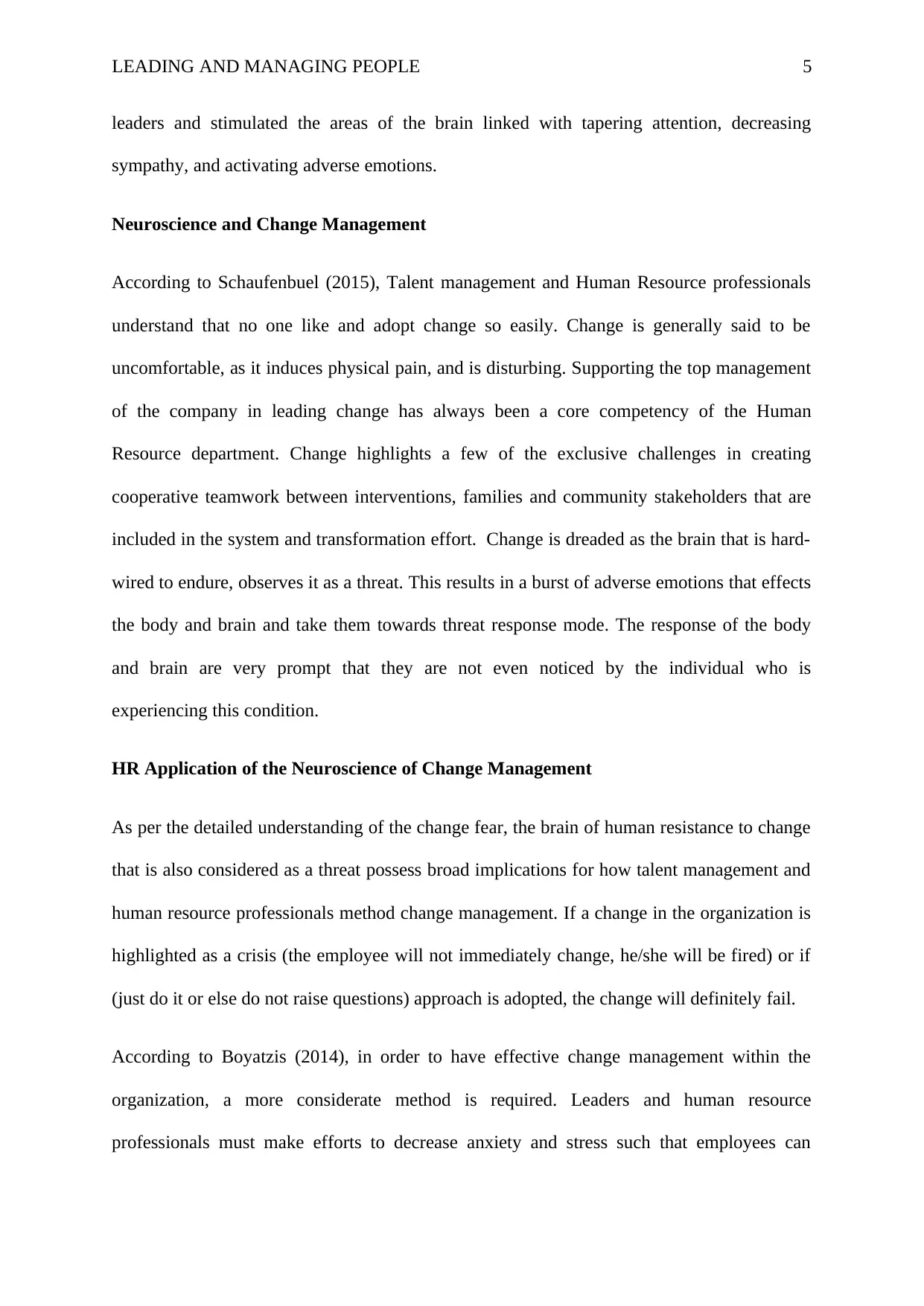
LEADING AND MANAGING PEOPLE 5
leaders and stimulated the areas of the brain linked with tapering attention, decreasing
sympathy, and activating adverse emotions.
Neuroscience and Change Management
According to Schaufenbuel (2015), Talent management and Human Resource professionals
understand that no one like and adopt change so easily. Change is generally said to be
uncomfortable, as it induces physical pain, and is disturbing. Supporting the top management
of the company in leading change has always been a core competency of the Human
Resource department. Change highlights a few of the exclusive challenges in creating
cooperative teamwork between interventions, families and community stakeholders that are
included in the system and transformation effort. Change is dreaded as the brain that is hard-
wired to endure, observes it as a threat. This results in a burst of adverse emotions that effects
the body and brain and take them towards threat response mode. The response of the body
and brain are very prompt that they are not even noticed by the individual who is
experiencing this condition.
HR Application of the Neuroscience of Change Management
As per the detailed understanding of the change fear, the brain of human resistance to change
that is also considered as a threat possess broad implications for how talent management and
human resource professionals method change management. If a change in the organization is
highlighted as a crisis (the employee will not immediately change, he/she will be fired) or if
(just do it or else do not raise questions) approach is adopted, the change will definitely fail.
According to Boyatzis (2014), in order to have effective change management within the
organization, a more considerate method is required. Leaders and human resource
professionals must make efforts to decrease anxiety and stress such that employees can
leaders and stimulated the areas of the brain linked with tapering attention, decreasing
sympathy, and activating adverse emotions.
Neuroscience and Change Management
According to Schaufenbuel (2015), Talent management and Human Resource professionals
understand that no one like and adopt change so easily. Change is generally said to be
uncomfortable, as it induces physical pain, and is disturbing. Supporting the top management
of the company in leading change has always been a core competency of the Human
Resource department. Change highlights a few of the exclusive challenges in creating
cooperative teamwork between interventions, families and community stakeholders that are
included in the system and transformation effort. Change is dreaded as the brain that is hard-
wired to endure, observes it as a threat. This results in a burst of adverse emotions that effects
the body and brain and take them towards threat response mode. The response of the body
and brain are very prompt that they are not even noticed by the individual who is
experiencing this condition.
HR Application of the Neuroscience of Change Management
As per the detailed understanding of the change fear, the brain of human resistance to change
that is also considered as a threat possess broad implications for how talent management and
human resource professionals method change management. If a change in the organization is
highlighted as a crisis (the employee will not immediately change, he/she will be fired) or if
(just do it or else do not raise questions) approach is adopted, the change will definitely fail.
According to Boyatzis (2014), in order to have effective change management within the
organization, a more considerate method is required. Leaders and human resource
professionals must make efforts to decrease anxiety and stress such that employees can
⊘ This is a preview!⊘
Do you want full access?
Subscribe today to unlock all pages.

Trusted by 1+ million students worldwide

LEADING AND MANAGING PEOPLE 6
concentrate on the positive features of the planned change, by listening to employees
concerns and asking questions. This procedure will improve the ability of the brain to amend
its retort to the change and notice it as a non-threatening approach.
The BAL Approach
The BAL Approach is comprised of four main pillars. They are considered as the four major
groups of practical recommendations, ideas and scientific insights that have been collected,
managed and utilized as a complete brain-based method in the business, personal lives, and
educational areas. According to Hodgkinson and Healey (2011), this approach has been
created with the support of a number of scientific literatures concentrating on the modern
conceivable visions and uniting them with typical ones.
Pillar 1- Thinking
This first pillar of thinking highlights the brain's cognitive function. It is said to be the longest
pillar since businesses and leaders are under the great requirement of learning how to think in
a brain-based way. Following this supports leaders in discharging the true power of their
investigative thinking. Being a brain based leader supports in increasing and maintaining
willpower. The leader’s decision and thoughts can never be strong, pertinent, valuable and
stirring if he/she will unnecessarily waste their brain energy. Hence, leaders have to
continually conscious of biases to deliberately decide when these biases are useful and when
they aren’t. Familiarizing a profound and expressive individual drive aids leaders to track
their thoughts (Dimitriadis and Psychogios, 2016). Similarly, the capability to identify and
involve in the flow of best mental state will support leaders increase clearness, efficiency, and
efficiency of thinking. Creative thinking arises as a significant kind of thinking since
ingenious problem solving is essential when experiencing regular changes and disruption.
Pillar 2 Emotions
concentrate on the positive features of the planned change, by listening to employees
concerns and asking questions. This procedure will improve the ability of the brain to amend
its retort to the change and notice it as a non-threatening approach.
The BAL Approach
The BAL Approach is comprised of four main pillars. They are considered as the four major
groups of practical recommendations, ideas and scientific insights that have been collected,
managed and utilized as a complete brain-based method in the business, personal lives, and
educational areas. According to Hodgkinson and Healey (2011), this approach has been
created with the support of a number of scientific literatures concentrating on the modern
conceivable visions and uniting them with typical ones.
Pillar 1- Thinking
This first pillar of thinking highlights the brain's cognitive function. It is said to be the longest
pillar since businesses and leaders are under the great requirement of learning how to think in
a brain-based way. Following this supports leaders in discharging the true power of their
investigative thinking. Being a brain based leader supports in increasing and maintaining
willpower. The leader’s decision and thoughts can never be strong, pertinent, valuable and
stirring if he/she will unnecessarily waste their brain energy. Hence, leaders have to
continually conscious of biases to deliberately decide when these biases are useful and when
they aren’t. Familiarizing a profound and expressive individual drive aids leaders to track
their thoughts (Dimitriadis and Psychogios, 2016). Similarly, the capability to identify and
involve in the flow of best mental state will support leaders increase clearness, efficiency, and
efficiency of thinking. Creative thinking arises as a significant kind of thinking since
ingenious problem solving is essential when experiencing regular changes and disruption.
Pillar 2 Emotions
Paraphrase This Document
Need a fresh take? Get an instant paraphrase of this document with our AI Paraphraser

LEADING AND MANAGING PEOPLE 7
The second pillar is about the emotional life of the brain. According to Bal, Campbell and
Larsen (2011), a human being is not always fit for expressing and understanding their own
emotions and it results in an emerging number of challenges for the leaders. Being capable to
identify the correct emotion at the initial stage and deal with it consequently is vital for
improved leadership. Emotional quickness and emotional equations can do wonders for the
leaders that time they are utilized suitably. This pillar majorly concentrates on how to alter
the emotions in order to fit with the up-to-date leadership style. Leaders in the organization
need to work in order to inspect their tempers or semi-stable emotional conditions since a
negative mental state or mood can extinguish the cooperative team spirit or an organization or
department.
Pillar 3 Brain Automation
The third pillar is about the protocols and automates responses of the brains. Priming is the
procedure through, which the leader can push their own brain and others in the direction of
particular behavior or decision, and is applied every day (Bal, 2017). Through priming,
leaders could enhance their creativity, social connectivity, and productivity. The recent
research suggests that altering habits and making a set of favorable ones, for ourselves and
others, is not so tough if a correct procedure is followed. In order to boost effective
leadership, it is very essential to terminate adverse habits and make positive ones. With
constant alterations and challenges in the business environment, the brain gets automatically
developed to react with the changing surroundings. It is important that the modern leader has
to understand the relationship between the physical world and brain and must make use of the
spaces to attain anticipated behavioral responses.
Pillar 4 Relations
The second pillar is about the emotional life of the brain. According to Bal, Campbell and
Larsen (2011), a human being is not always fit for expressing and understanding their own
emotions and it results in an emerging number of challenges for the leaders. Being capable to
identify the correct emotion at the initial stage and deal with it consequently is vital for
improved leadership. Emotional quickness and emotional equations can do wonders for the
leaders that time they are utilized suitably. This pillar majorly concentrates on how to alter
the emotions in order to fit with the up-to-date leadership style. Leaders in the organization
need to work in order to inspect their tempers or semi-stable emotional conditions since a
negative mental state or mood can extinguish the cooperative team spirit or an organization or
department.
Pillar 3 Brain Automation
The third pillar is about the protocols and automates responses of the brains. Priming is the
procedure through, which the leader can push their own brain and others in the direction of
particular behavior or decision, and is applied every day (Bal, 2017). Through priming,
leaders could enhance their creativity, social connectivity, and productivity. The recent
research suggests that altering habits and making a set of favorable ones, for ourselves and
others, is not so tough if a correct procedure is followed. In order to boost effective
leadership, it is very essential to terminate adverse habits and make positive ones. With
constant alterations and challenges in the business environment, the brain gets automatically
developed to react with the changing surroundings. It is important that the modern leader has
to understand the relationship between the physical world and brain and must make use of the
spaces to attain anticipated behavioral responses.
Pillar 4 Relations
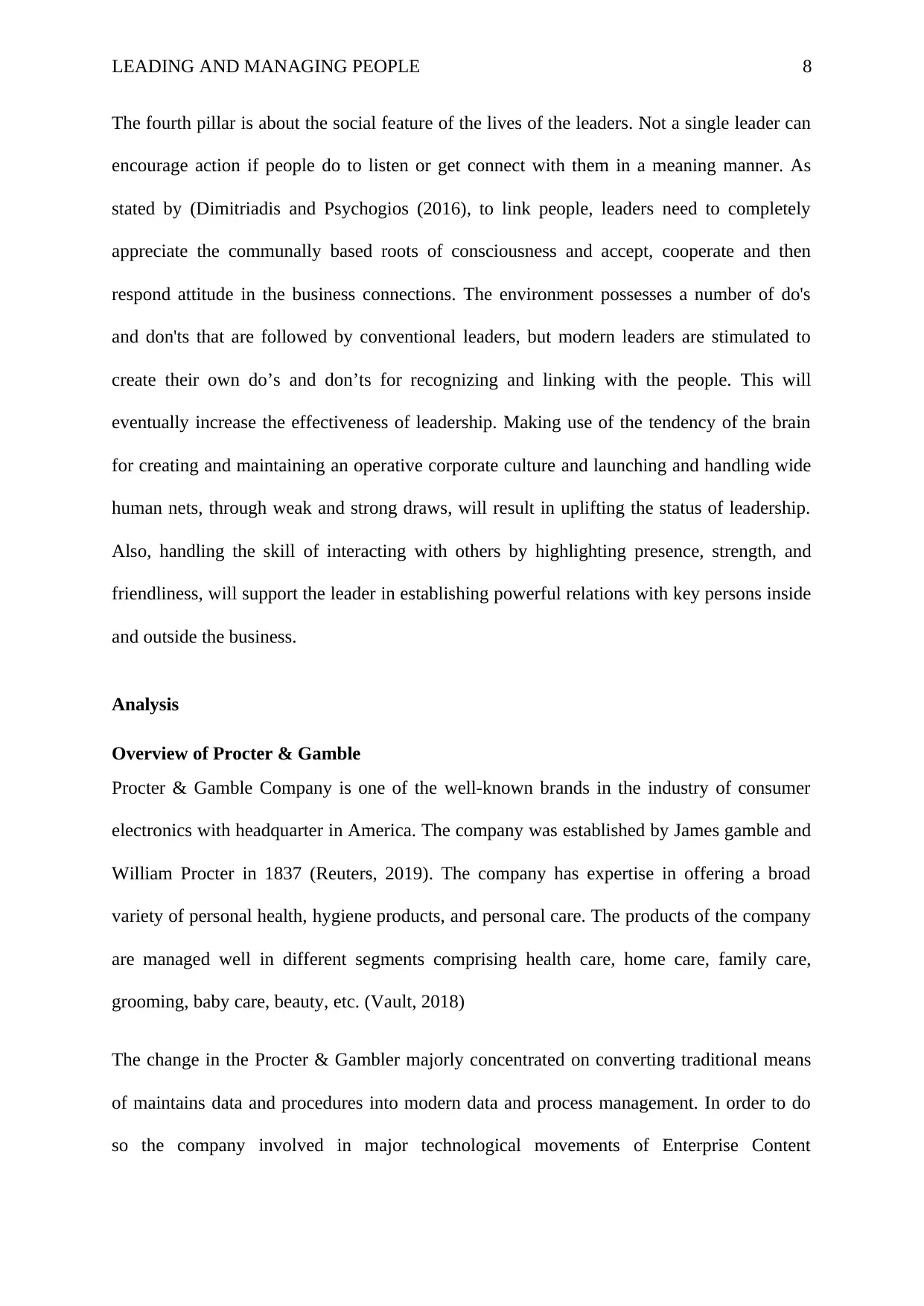
LEADING AND MANAGING PEOPLE 8
The fourth pillar is about the social feature of the lives of the leaders. Not a single leader can
encourage action if people do to listen or get connect with them in a meaning manner. As
stated by (Dimitriadis and Psychogios (2016), to link people, leaders need to completely
appreciate the communally based roots of consciousness and accept, cooperate and then
respond attitude in the business connections. The environment possesses a number of do's
and don'ts that are followed by conventional leaders, but modern leaders are stimulated to
create their own do’s and don’ts for recognizing and linking with the people. This will
eventually increase the effectiveness of leadership. Making use of the tendency of the brain
for creating and maintaining an operative corporate culture and launching and handling wide
human nets, through weak and strong draws, will result in uplifting the status of leadership.
Also, handling the skill of interacting with others by highlighting presence, strength, and
friendliness, will support the leader in establishing powerful relations with key persons inside
and outside the business.
Analysis
Overview of Procter & Gamble
Procter & Gamble Company is one of the well-known brands in the industry of consumer
electronics with headquarter in America. The company was established by James gamble and
William Procter in 1837 (Reuters, 2019). The company has expertise in offering a broad
variety of personal health, hygiene products, and personal care. The products of the company
are managed well in different segments comprising health care, home care, family care,
grooming, baby care, beauty, etc. (Vault, 2018)
The change in the Procter & Gambler majorly concentrated on converting traditional means
of maintains data and procedures into modern data and process management. In order to do
so the company involved in major technological movements of Enterprise Content
The fourth pillar is about the social feature of the lives of the leaders. Not a single leader can
encourage action if people do to listen or get connect with them in a meaning manner. As
stated by (Dimitriadis and Psychogios (2016), to link people, leaders need to completely
appreciate the communally based roots of consciousness and accept, cooperate and then
respond attitude in the business connections. The environment possesses a number of do's
and don'ts that are followed by conventional leaders, but modern leaders are stimulated to
create their own do’s and don’ts for recognizing and linking with the people. This will
eventually increase the effectiveness of leadership. Making use of the tendency of the brain
for creating and maintaining an operative corporate culture and launching and handling wide
human nets, through weak and strong draws, will result in uplifting the status of leadership.
Also, handling the skill of interacting with others by highlighting presence, strength, and
friendliness, will support the leader in establishing powerful relations with key persons inside
and outside the business.
Analysis
Overview of Procter & Gamble
Procter & Gamble Company is one of the well-known brands in the industry of consumer
electronics with headquarter in America. The company was established by James gamble and
William Procter in 1837 (Reuters, 2019). The company has expertise in offering a broad
variety of personal health, hygiene products, and personal care. The products of the company
are managed well in different segments comprising health care, home care, family care,
grooming, baby care, beauty, etc. (Vault, 2018)
The change in the Procter & Gambler majorly concentrated on converting traditional means
of maintains data and procedures into modern data and process management. In order to do
so the company involved in major technological movements of Enterprise Content
⊘ This is a preview!⊘
Do you want full access?
Subscribe today to unlock all pages.

Trusted by 1+ million students worldwide

LEADING AND MANAGING PEOPLE 9
Management. The reason for adopting this was the stable revenue and profit growth of the
company. This is despite the company's investment in different major promotional and
advertisement investments and improvement programs. Besides this, the company is involved
in different attractive and emotional promotional activities to encourage sympathy towards
uneducated and poor children and empowering equality.
Adaptation of Enterprise Content Management created a number of issues for the company
due to the incapability of the leaders to involve all its stakeholders into the successful
implementation of the procedure. It has not ensured the participation of the stakeholders into
the decision making a procedure which is one of the drawbacks for the business (P&G,
2013).
Enterprise Content Management allows business to spread the content across their diverse
applications. It also supported the company is moving towards more structured content
management and offer information to the external and internal stakeholders in order to enable
information life cycle management. Procter & Gambler got support through this in creating,
storing, retrieving and distributing the information that enhanced collaboration and trimmed
cost. There is always a need for virtual working opportunities and decreasing workload due to
the availability of web-based space. Hence, it is essential to execute cleverer working
practices and emphases on the requirement of a complete integrated web-based services
management environment (McKinsey, 2005). This change in the company is aligned with the
company’s mission to make use of innovative technologies into the operations of the business
that will assist P&G to operate faster, efficiently, and smarter.
The company has been involved in the change management procedure and implemented this
new system into its operations present across the world. With the implementation of the
system, the efforts of the employees have been reduced and management of the data has been
Management. The reason for adopting this was the stable revenue and profit growth of the
company. This is despite the company's investment in different major promotional and
advertisement investments and improvement programs. Besides this, the company is involved
in different attractive and emotional promotional activities to encourage sympathy towards
uneducated and poor children and empowering equality.
Adaptation of Enterprise Content Management created a number of issues for the company
due to the incapability of the leaders to involve all its stakeholders into the successful
implementation of the procedure. It has not ensured the participation of the stakeholders into
the decision making a procedure which is one of the drawbacks for the business (P&G,
2013).
Enterprise Content Management allows business to spread the content across their diverse
applications. It also supported the company is moving towards more structured content
management and offer information to the external and internal stakeholders in order to enable
information life cycle management. Procter & Gambler got support through this in creating,
storing, retrieving and distributing the information that enhanced collaboration and trimmed
cost. There is always a need for virtual working opportunities and decreasing workload due to
the availability of web-based space. Hence, it is essential to execute cleverer working
practices and emphases on the requirement of a complete integrated web-based services
management environment (McKinsey, 2005). This change in the company is aligned with the
company’s mission to make use of innovative technologies into the operations of the business
that will assist P&G to operate faster, efficiently, and smarter.
The company has been involved in the change management procedure and implemented this
new system into its operations present across the world. With the implementation of the
system, the efforts of the employees have been reduced and management of the data has been
Paraphrase This Document
Need a fresh take? Get an instant paraphrase of this document with our AI Paraphraser

LEADING AND MANAGING PEOPLE 10
enhanced into the organization, which has resulted in enhancing the procedure of decision
making (Seeking Alpha, 2018). The neuro-leadership in the company has resulted in this
change by understanding the work pressure over its employees. It is known that increasing
work pressure results in reducing the productivity of the employees and eventually the
revenue of the company. Hence, it is important for the leaders in the organization to adopt
this leadership style while making decisions into the business and making changes.
In relation to changes in the promotional campaigns and advertisement of the company, P&G
has tried to make a drastic change in society. The management of the company has adopted
the Neuroleadership into its procedures by understanding the changing mindset of the
stakeholders and accordingly offering products and advertising them in the market (P&G,
2019). The Resonant leadership is followed in this company. By introducing different
advertisement strategies such as
Asking customers to purchase any of the P&G products and support in the education
of children
Thanking Mom Campaign
Both these change in the advertisement have brought a tremendous change in society and
supported the company in improving its image and profit in the market across the places
where it operates its business (Katumba, 2018). The leaders of the company do not only think
from the perspective of increasing its revenue and profits. But it also gives priority to its
stakeholders and society by contributing a great amount towards development. The
management of the company follows the BAL Approach here, where it focuses on creative
thinking towards social development. Besides this, it is focusing on creating a positive habit
and behavior among customers as well as employees by asking to purchase a product that
will contribute to the development of children and society (Marketing Week, 2009). The
enhanced into the organization, which has resulted in enhancing the procedure of decision
making (Seeking Alpha, 2018). The neuro-leadership in the company has resulted in this
change by understanding the work pressure over its employees. It is known that increasing
work pressure results in reducing the productivity of the employees and eventually the
revenue of the company. Hence, it is important for the leaders in the organization to adopt
this leadership style while making decisions into the business and making changes.
In relation to changes in the promotional campaigns and advertisement of the company, P&G
has tried to make a drastic change in society. The management of the company has adopted
the Neuroleadership into its procedures by understanding the changing mindset of the
stakeholders and accordingly offering products and advertising them in the market (P&G,
2019). The Resonant leadership is followed in this company. By introducing different
advertisement strategies such as
Asking customers to purchase any of the P&G products and support in the education
of children
Thanking Mom Campaign
Both these change in the advertisement have brought a tremendous change in society and
supported the company in improving its image and profit in the market across the places
where it operates its business (Katumba, 2018). The leaders of the company do not only think
from the perspective of increasing its revenue and profits. But it also gives priority to its
stakeholders and society by contributing a great amount towards development. The
management of the company follows the BAL Approach here, where it focuses on creative
thinking towards social development. Besides this, it is focusing on creating a positive habit
and behavior among customers as well as employees by asking to purchase a product that
will contribute to the development of children and society (Marketing Week, 2009). The
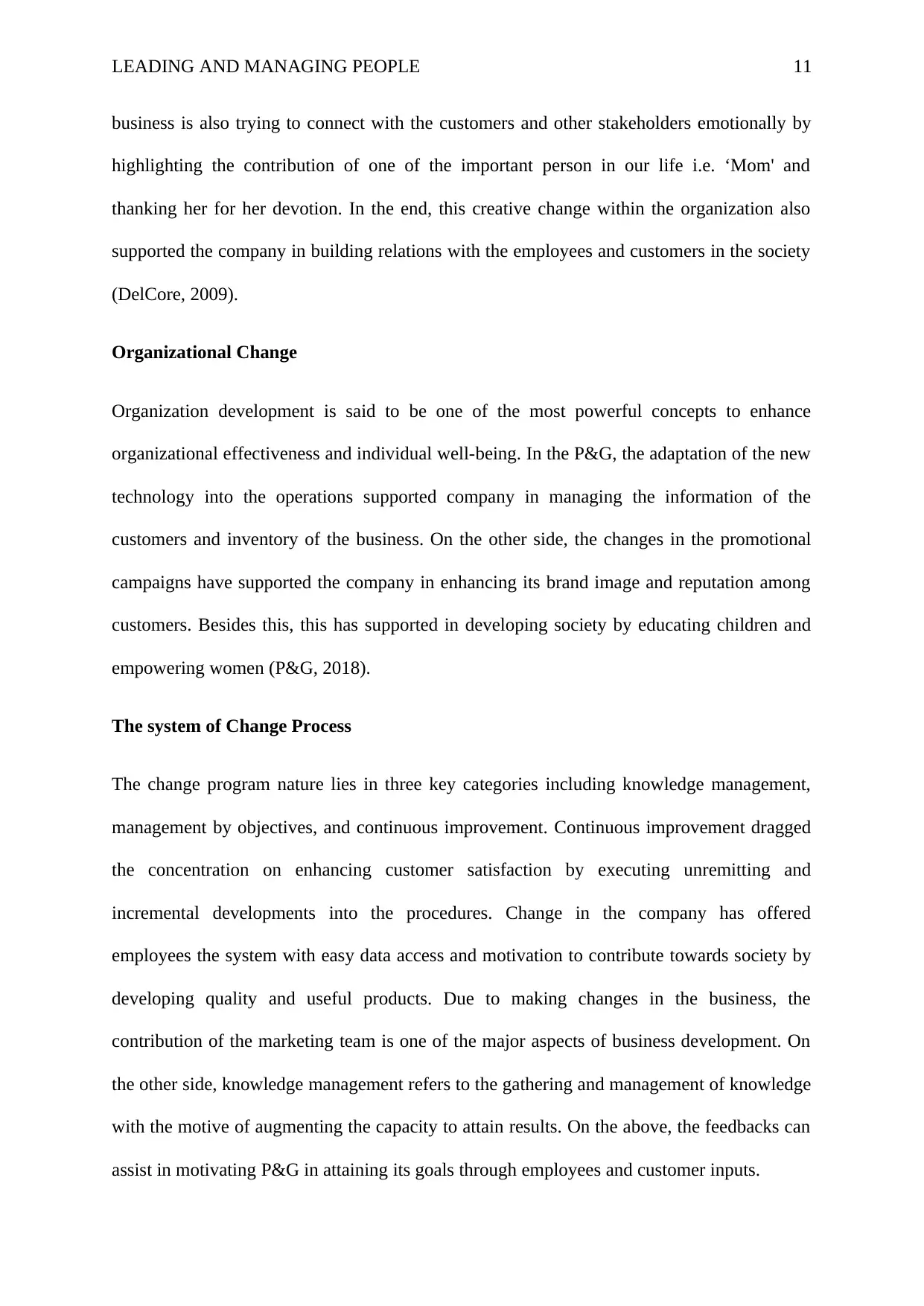
LEADING AND MANAGING PEOPLE 11
business is also trying to connect with the customers and other stakeholders emotionally by
highlighting the contribution of one of the important person in our life i.e. ‘Mom' and
thanking her for her devotion. In the end, this creative change within the organization also
supported the company in building relations with the employees and customers in the society
(DelCore, 2009).
Organizational Change
Organization development is said to be one of the most powerful concepts to enhance
organizational effectiveness and individual well-being. In the P&G, the adaptation of the new
technology into the operations supported company in managing the information of the
customers and inventory of the business. On the other side, the changes in the promotional
campaigns have supported the company in enhancing its brand image and reputation among
customers. Besides this, this has supported in developing society by educating children and
empowering women (P&G, 2018).
The system of Change Process
The change program nature lies in three key categories including knowledge management,
management by objectives, and continuous improvement. Continuous improvement dragged
the concentration on enhancing customer satisfaction by executing unremitting and
incremental developments into the procedures. Change in the company has offered
employees the system with easy data access and motivation to contribute towards society by
developing quality and useful products. Due to making changes in the business, the
contribution of the marketing team is one of the major aspects of business development. On
the other side, knowledge management refers to the gathering and management of knowledge
with the motive of augmenting the capacity to attain results. On the above, the feedbacks can
assist in motivating P&G in attaining its goals through employees and customer inputs.
business is also trying to connect with the customers and other stakeholders emotionally by
highlighting the contribution of one of the important person in our life i.e. ‘Mom' and
thanking her for her devotion. In the end, this creative change within the organization also
supported the company in building relations with the employees and customers in the society
(DelCore, 2009).
Organizational Change
Organization development is said to be one of the most powerful concepts to enhance
organizational effectiveness and individual well-being. In the P&G, the adaptation of the new
technology into the operations supported company in managing the information of the
customers and inventory of the business. On the other side, the changes in the promotional
campaigns have supported the company in enhancing its brand image and reputation among
customers. Besides this, this has supported in developing society by educating children and
empowering women (P&G, 2018).
The system of Change Process
The change program nature lies in three key categories including knowledge management,
management by objectives, and continuous improvement. Continuous improvement dragged
the concentration on enhancing customer satisfaction by executing unremitting and
incremental developments into the procedures. Change in the company has offered
employees the system with easy data access and motivation to contribute towards society by
developing quality and useful products. Due to making changes in the business, the
contribution of the marketing team is one of the major aspects of business development. On
the other side, knowledge management refers to the gathering and management of knowledge
with the motive of augmenting the capacity to attain results. On the above, the feedbacks can
assist in motivating P&G in attaining its goals through employees and customer inputs.
⊘ This is a preview!⊘
Do you want full access?
Subscribe today to unlock all pages.

Trusted by 1+ million students worldwide
1 out of 20
Related Documents
Your All-in-One AI-Powered Toolkit for Academic Success.
+13062052269
info@desklib.com
Available 24*7 on WhatsApp / Email
![[object Object]](/_next/static/media/star-bottom.7253800d.svg)
Unlock your academic potential
Copyright © 2020–2025 A2Z Services. All Rights Reserved. Developed and managed by ZUCOL.





